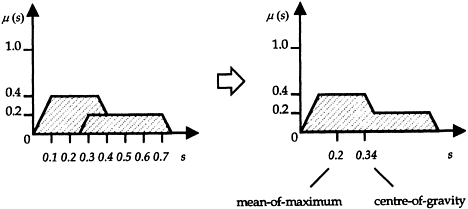78.
| [Cover] [Contents] [Index] |
Page 168
The mean-of-maximum method generates a deterministic value by taking the average of some measurement s whose membership grades μ(s) are a maximum. In the discrete case, this is calculated by:
 |
(4.35) |
where m denotes the number of s reaching the relatively maximal membership grade (described below). An example is given in Figure 4.11, which follows the result of Figure 4.10. Assume that the air-conditioner controller contains seven choices, e.g. the values 0.1, 0.2,…0.7 (refer to Figure 4.11). Using the centre-of-gravity method, the defuzzification value is calculated as:
 |
(4.36) |
Using the mean-of-maximum defuzzification method, only three sample elements reach the relatively maximal membership grade, i.e. elements 0.1, 0.2 and 0.3 with the membership grade of 0.4, which results in:
 |
(4.37) |
Using these three steps (fuzzification, inference and defuzzification), one eventually reaches a solution. In the case of the air-conditioner dial, the setting should be 0.34 if the centre-of-gravity method is applied.

Figure 4.11 Defuzzification methods on a discrete domain result in deterministic values, 0.2 (mean-of-maximum) and 0.34 (centre-of-gravity).
| [Cover] [Contents] [Index] |
EAN: 2147483647
Pages: 354